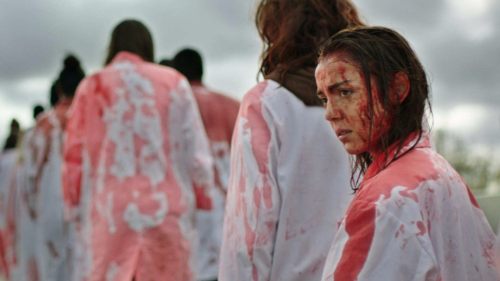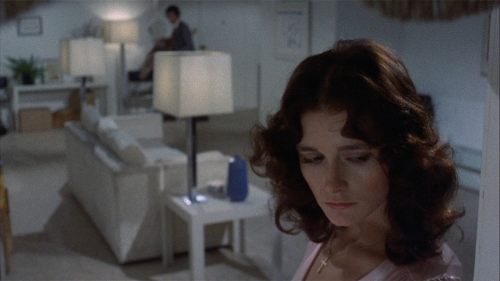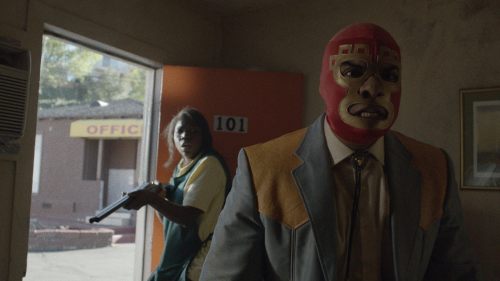Blood, Sex And Sisterhood: On the Cinematic Narrative Of Female Siblings In RAW & SISTERS
Raw is coming out soon! Get your tickets here!
Blood. Sex. Sisterhood. Two women each discovering her own identity through a powerful familial bond, and their tendency towards vicious murder. These are the stories of four dangerous women driven mad by their own proximity, and the men who would dare to come between them. Sunk down beneath the surface of and Julia Ducournau’s cannibalistic Raw and Brian De Palma’s Psycho-esque Sisters is a tale of two siblings teetering on the brink of hysteria, as fate ties them together in these curious coming-of-age catastrophic fantasies as told by the fiercely feminist cinematic narrative of sisterhood.
In Brian De Palma’s Sisters, Dominique and Danielle are two Siamese twins who are physically conjoined at birth and forced to live out their lives together trapped in one body, forever attached at the hip, until one day a miraculous procedure successfully splits them. However, even though the operation has given the girls a fresh start, allowing them to finally exist as two separate entities, Dominique still just can’t let Danielle go, and she’ll do whatever it takes to keep her sister all to herself -- even if it means cutting down Danielle’s lover in cold blood.
It should’ve been a day of celebration; the anniversary of their birth. Dominique and Danielle always had fun together on their birthday. Still, when Danielle brings home a new lover and he tries to intrude on their special day by gifting them a birthday cake, Dominique lashes out in a blind jealous rage, and stabs the man to death before the girls even get to blow out the candles. Now, with her lover’s blood on her hands, a body in her apartment, and her sister nowhere to be found, Danielle struggles to cover up for her Dominique’s heinous act. At the same time, her neighbor, a reporter by the name of Grace Collier, who saw what happened, simultaneously attempts to drag a man of the law to the scene of the crime before all of the evidence can be wiped away.
Although Danielle, along with the help of her ex-husband Emil, manages to soak up the crimson splatter and hide the corpse before the cops come knocking at her door, Grace swears she saw a man murdered in this apartment, and becomes hell-bent on discovering the truth about the twins. From that point forward she makes it her mission to find the man that the sisters killed and bring the girls to justice, but sadly, even she fails to recognize the power of the bond that binds them, and the terror that befalls anyone who attempts to trifle with their sacred connection. No man can come between Dominique and Danielle, but no woman can, either.
Similarly, in Julia Ducouranu’s Raw, a non-meat eating wallflower named Justine enlists in veterinary school, and through the guidance of her older sister Alexia, makes a startlingly self-discovery – this vegetarian likes the taste of human flesh. As Justine comes to terms with her newfound cravings, so too does she grow and evolve into a fully realized sexual being, tumbling down the rabbit hole of womanhood at a frantic pace. Now, as this once aloof star student happily gives in to every sinful temptation that comes her way, she finds herself caught between a feeling of elation over her latest epiphany, and resentment towards her sister for awakening the bloodthirsty beast within herself– within the same blood that they both share.
In both Sisters and in Raw sexual acts prompt and coincide with the tendency toward violent acts. Just as Danielle discovers that she is as protective and violent towards anyone who tries to insert themselves between she and Dominique, Justine realizes that she, too, wants to keep her sister all to herself, because only her sister truly understands her -- the same can arguably be said about Alexia’s feelings toward Justine. Both stories feature women who evolve into more actualized human beings once their sisters pave the way to understanding themselves. Only the one who shares the same infected blood can point the way to self-acceptance, and only your sister will truly be there for you when you have a body that needs disposing of. It takes a true sibling to stand by your side while you’re holding a bloody kitchen knife in your hand – or, in certain circumstances, a bloody ski pole.
The inspiration for Sisters actually comes from a startling image that director Brian De Palma stumbled upon in an article in a 1966 issue of Life Magazine. The picture showed two conjoined Soviet twins named Masha and Dasha, and a caption in the bottom right corner reads something along the lines of “Although they are physiologically normal, as they get older, they are starting to develop mental problems”. Intrigued by this strange scenario, De Palma dreamed up a story about two Siamese twins who would eventually be surgically separated, resulting in one sister going mad and attacking any man who would dare try to date her one and only human connection. Influenced, as always, by Hitchcock, De Palma took his grand idea of a sibling set slasher and filled it to the brim with nods to his favorite filmmaker, giving it a very Psycho first act, as he kills off a lead character more than thirty minutes in, followed up by a small Rope homage as he uses as long of a take as possible to show the detective and reporter Collier making their way around Danielle’s apartment while looking for a body, all the while keeping a cool Rear Window style ever present with several characters watching important plot points develop through binoculars, typically from across the street, just as Jimmy Stewart does as Hitchcock’s classic wheelchair bound neighborly hero. During the editing process, he and Paul Hirsch even grew to believe it was necessary to get Bernard Herrmann to do the score.
De Palma is not character driven or a man of many words. He finds that too much chatter makes for a dull movie, and instead opts to find inspiration in a large set piece, or a big idea, and then shapes his story around that idea to match the image that he has in his head. Likewise, Raw director Ducournau is more into scoring long moments of silence rather than incorporating a ton of dialogue to explain what’s happening, and finds herself inspired by images of certain peculiar body movements, which she then uses as a jumping off point to build a narrative around. Therefore, although each director has his or her own way of doing it, the story actually comes second to the aesthetics for both filmmakers. Despite the difference in age, sex, birthplace, and point in time, they do share the habit of conjuring up strong visceral visuals and writing whatever is necessary to bring that visual to life.
In the case of these films, both of those visuals eventually came to involve sisters, and each showed the power of coming to terms with one’s own identity through the guiding force of her own female sibling. Blood, sex and carnage lined the path to self-actualization, but once each sister sets out to find herself, there was no turning back from the murderess that they would inevitably become.



